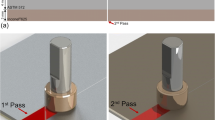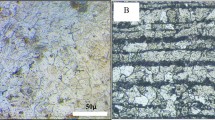Abstract
Common welding processes that are used for cladding causes dilution and therefore, there is a need to explore new processes of cladding. In this work, friction stir welding process has been used to successfully clad 3 mm thick copper sheet on a 6 mm thick mild steel substrate. The process is different from lap welding, not only because of its intended purpose, but also because several FSW passes are needed to cover the entire surface of the substrate. After one FSW pass, successive passes were carried out to cover a wider width of the clad layer by offsetting the tool. Metallurgical examination of the transverse cross-section of cladded samples was carried out using optical microscopy, SEM–EDS, microhardness test, and XRD. Surface jetting type features, normally seen in explosive welding, were observed at the interface of the two materials. The average grain size of steel substrate below the clad layer for both single and triple passes showed refined grains with size of 3.9 µm and 4.2 µm respectively indicating an improvement of more than 60% over the base steel. Although there was plastic flow of material, the substrate material could not make to the top surface of the clad layer. XRD analysis confirmed no new phases were observed on the top surface of the clad layer after cladding. However, the interface region on the transverse cross-section confirmed the presence of Cu0.8Fe0.2 and Cu0.3Fe1.7 intermetallics. Microhardness for copper clad region remained nearly same across all the passes. However, for the steel substrate, higher hardness values were found near the stir zone due to grain refinement for single pass clad while for double and triple passes, a slight reduction was recorded possibly due to metal transfer across the boundary upon second and third passes.

















Similar content being viewed by others
Data availability
The authors confirm that the data supporting the findings of this study are available within the article.
Code availability
Not applicable.
References
Kaierle S, Barroi A, Noelke C, Hermsdorf J, Overmeyer L, Haferkamp H (2012) Review on laser deposition welding: from micro to macro. Phys Procedia 39:336–345
Singhal TS, Jain JK (2020) GMAW cladding on metals to impart anti-corrosiveness: machine, processes and materials. Mater Today Proc 26:2432–2441
Baboian R, Haynes G, Turcotte R (1988) Galvanic corrosion on automobiles. In: Hack H (ed) Galvanic corrosion. ASTM International, West Conshohocken, p 249– 259. https://doi.org/10.1520/STP26203S
Sasaki T, Barkey M, Thompson G, Syarif Y, Fox D (2011) Microstructural evolution of copper clad steel bimetallic wire. Mater Sci Eng, A 528(6):2974–2981
Choi H-J, Lee M, Lee JY (2010) Application of a cold spray technique to the fabrication of a copper canister for the geological disposal of CANDU spent fuels. Nucl Eng Des 240(10):2714–2720
Wei P, Chung F (2000) Unsteady Marangoni flow in a molten pool when welding dissimilar metals. Metall and Mater Trans B 31(6):1387–1403
Yang T, Gao H, Zhang S, Wu L (2013) Interface behavior of copper and steel by plasma-MIG hybrid arc welding. Acta Metall Sin (English Letters) 26(3):328–332
Magnabosco I, Ferro P, Bonollo F, Arnberg L (2006) An investigation of fusion zone microstructures in electron beam welding of copper–stainless steel. Mater Sci Eng A 424(1–2):163–173
Chen S, Huang J, Xia J, Zhang H, Zhao X (2013) Microstructural characteristics of a stainless steel/copper dissimilar joint made by laser welding. Metall and Mater Trans A 44(8):3690–3696
Yao C, Xu B, Zhang X, Huang J, Fu J, Wu Y (2009) Interface microstructure and mechanical properties of laser welding copper–steel dissimilar joint. Opt Lasers Eng 47(7–8):807–814
Singh S, Kumar M, Sodhi GPS, Buddu RK, Singh H (2018) Development of thick copper claddings on SS316L steel for in-vessel components of fusion reactors and copper-cast iron canisters. Fusion Eng Des 128:126–137
Meitei RB, Maji P, Samadhiya A, Karmakar R, Ghosh SK, Saha SC (2019) An experimental investigation on joining of copper and stainless steel by induction welding technique. International Journal of Precision Engineering and Manufacturing 1–9. https://doi.org/10.1007/s12541-019-00284-w
Liu B, Wei J, Yang M, Yin F, Xu K (2018) Effect of heat treatment on the mechanical properties of copper clad steel plates. Vacuum 154:250–258
Durgutlu A, Gülenç B, Findik F (2005) Examination of copper/stainless steel joints formed by explosive welding. Mater Des 26(6):497–507
Wan L, Huang Y (2018) Friction stir welding of dissimilar aluminum alloys and steels: a review. Int J Adv Manuf Technol 99(5):1781–1811
Emamian SS, Awang M, Yusof F, Sheikholeslam M, Mehrpouya M (2020) Improving the friction stir welding tool life for joining the metal matrix composites. Int J Adv Manuf Technol 106(7):3217–3227
Barooni O, Abbasi M, Givi M, Bagheri B (2017) New method to improve the microstructure and mechanical properties of joint obtained using FSW. Int J Adv Manuf Technol 93(9):4371–4378
Kulekci MK, Esme U, Buldum B (2016) Critical analysis of friction stir-based manufacturing processes. Int J Adv Manuf Technol 85(5):1687–1712
Osman N, Sajuri Z, Baghdadi AH, Omar MZ (2019) Effect of process parameters on interfacial bonding properties of aluminium–copper clad sheet processed by multi-pass friction stir-welding technique. Metals 9(11):1159
Shen Z, Chen Y, Haghshenas M, Nguyen T, Galloway J, Gerlich A (2015) Interfacial microstructure and properties of copper clad steel produced using friction stir welding versus gas metal arc welding. Mater Charact 104:1–9
Imani Y, Givi M, Guillot M Improving friction stir welding between copper and 304L stainless steel. In: Advanced Materials Research, 2012. Trans Tech Publ, pp 263-268
Jafari M, Abbasi M, Poursina D, Gheysarian A, Bagheri B (2017) Microstructures and mechanical properties of friction stir welded dissimilar steel-copper joints. J Mech Sci Technol 31(3):1135–1142. https://doi.org/10.1007/s12206-016-1217-z
Wang T, Shukla S, Nene SS, Frank M, Wheeler RW, Mishra RS (2018) Towards obtaining sound butt joint between metallurgically immiscible pure Cu and stainless steel through friction stir welding. Metall and Mater Trans A 49(7):2578–2582
Baillie P, Campbell S, Galloway A, Cater S, McPherson N (2015) Friction stir welding of 6 mm thick carbon steel underwater and in air. Sci Technol Weld Joining 20(7):585–593
Xu N, Ueji R, Fujii H (2015) Enhanced mechanical properties of 70/30 brass joint by multi-pass friction stir welding with rapid cooling. Sci Technol Weld Joining 20(2):91–99
Tiwari A, Singh P, Pankaj P, Biswas P, Kore SD (2019) FSW of low carbon steel using tungsten carbide (WC-10wt.% Co) based tool material. J Mech Sci Technol 33(10):4931–4938
Funding
Received from SERB, Department of Science and Technology, Government of India (Sanction no. SERB No: SB/S3/MMER/0062/2013, dated 23rd April 2014) and IIT (BHU) under sprouting grant (letter No IIT (BHU)/Dev./2013–14/5110/L dated/3/2014).
Author information
Authors and Affiliations
Contributions
Mithlesh Kumar Mahto: experimentation, methodology, writing–original draft. Adarsh Kumar: visualization, conceptualization. Avinash Ravi Raja: visualization, conceptualization. Meghanshu Vashista: writing–review and editing, supervision. Mohd Zaheer Khan Yusufzai: writing–review and editing, supervision.
Corresponding author
Ethics declarations
Ethics approval and consent to participate
Not applicable.
Consent for publication
Not applicable.
Competing interests
The authors declare no competing interests.
Additional information
Publisher's Note
Springer Nature remains neutral with regard to jurisdictional claims in published maps and institutional affiliations.
Highlights
• New method of cladding has been attempted using friction stir welding process.
• Defect free cladded samples could be obtained at the process parameters and the extent of overlap of FSW passes.
• Multi pass cladding of 3 mm copper on 6 mm thick mild steel substrate carried out.
• Interlocking and intermixing across the interface between clad layer and substrate.
• Clad layer achieved with no substrate material reaching top ensuring zero dilution.
Rights and permissions
About this article
Cite this article
Mahto, M.K., Kumar, A., Raja, A.R. et al. Cladding of copper sheet on mild steel using friction stir welding. Int J Adv Manuf Technol 118, 3345–3360 (2022). https://doi.org/10.1007/s00170-021-08154-4
Received:
Accepted:
Published:
Issue Date:
DOI: https://doi.org/10.1007/s00170-021-08154-4




